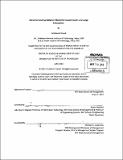| dc.contributor.advisor | Stuart Madnick. | en_US |
| dc.contributor.author | Trivedi, Hrishikesh | en_US |
| dc.contributor.other | Sloan School of Management. | en_US |
| dc.date.accessioned | 2013-09-12T19:18:40Z | |
| dc.date.available | 2013-09-12T19:18:40Z | |
| dc.date.copyright | 2013 | en_US |
| dc.date.issued | 2013 | en_US |
| dc.identifier.uri | http://hdl.handle.net/1721.1/80675 | |
| dc.description | Thesis (S.M.)--Massachusetts Institute of Technology, Sloan School of Management, 2013. | en_US |
| dc.description | Cataloged from PDF version of thesis. | en_US |
| dc.description | Includes bibliographical references (p. 79-81). | en_US |
| dc.description.abstract | Cloud Computing has held organizations across the globe spell bound with its promise. As it moves from being a buzz word and hype into adoption, organizations are faced with question of how to best adopt cloud. Existing frameworks of cloud adoption look at different aspects of cloud but stop short of taking a view of the complete spectrum and suggesting a path. Cloud Computing adoption requires that organizations have readiness on multiple dimensions including Governance, Process Analysis and Improvement, Application Rationalization and Modernization, and Hardware and Software Standardization. Readiness in turn determines how far organizations can go in their cloud programs with key milestones being Proof of Concepts, Infrastructure Service, Virtual Desktop, Platform Service and Enterprise Software as Service. Readiness and Milestones inform us about multiple stages in cloud adoption. The analysis also indicates that certain governance structures are most suitable for cloud adoption. The duration of cloud program for a large organization lies in years, even multiple five year plans. Analyses of case studies indicate all these views and the systems modeling for enterprise software as service, in addition corroborates the likely duration of cloud program. For systems model we have used factors such as Total Non-Cloud Applications, Rationalization and Modernization Rate, Rate of Conversion into Enterprise Software as Service and Budget. The proposed Cloud Computing Adoption Model can help organizations understand what capabilities they need to develop, where they are on the cloud adoption spectrum and how much time it could take to go to cloud. | en_US |
| dc.description.statementofresponsibility | by Hrishikesh Trivedi. | en_US |
| dc.format.extent | 81 p. | en_US |
| dc.language.iso | eng | en_US |
| dc.publisher | Massachusetts Institute of Technology | en_US |
| dc.rights | M.I.T. theses are protected by
copyright. They may be viewed from this source for any purpose, but
reproduction or distribution in any format is prohibited without written
permission. See provided URL for inquiries about permission. | en_US |
| dc.rights.uri | http://dspace.mit.edu/handle/1721.1/7582 | en_US |
| dc.subject | Sloan School of Management. | en_US |
| dc.title | Cloud computing adoption model for governments and large enterprises | en_US |
| dc.type | Thesis | en_US |
| dc.description.degree | S.M. | en_US |
| dc.contributor.department | Sloan School of Management | |
| dc.identifier.oclc | 857768311 | en_US |
